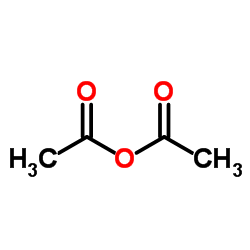1,4-DIACETOXY-2,3-DICYANOBENZENE

1,4-DIACETOXY-2,3-DICYANOBENZENE structure
|
Common Name | 1,4-DIACETOXY-2,3-DICYANOBENZENE | ||
|---|---|---|---|---|
| CAS Number | 83619-73-2 | Molecular Weight | 244.20300 | |
| Density | 1.34g/cm3 | Boiling Point | 447.5ºC at 760 mmHg | |
| Molecular Formula | C12H8N2O4 | Melting Point | 166-167ºC(lit.) | |
| MSDS | USA | Flash Point | 195.2ºC | |
Use of 1,4-DIACETOXY-2,3-DICYANOBENZENE1,4-Diacetoxy-2,3-dicyanobenzene is a cell-permeable fluorescent probe. 1,4-Diacetoxy-2,3-dicyanobenzene crosses the cell membrane and is cleaved by cytosolic esterases to the fluorescent pH indicator 2,3-dicyano-hydroquinone (DCH). 1,4-Diacetoxy-2,3-dicyanobenzene can be used to monitor intracellular pH[1]. |
| Name | (4-acetyloxy-2,3-dicyanophenyl) acetate |
|---|---|
| Synonym | More Synonyms |
| Description | 1,4-Diacetoxy-2,3-dicyanobenzene is a cell-permeable fluorescent probe. 1,4-Diacetoxy-2,3-dicyanobenzene crosses the cell membrane and is cleaved by cytosolic esterases to the fluorescent pH indicator 2,3-dicyano-hydroquinone (DCH). 1,4-Diacetoxy-2,3-dicyanobenzene can be used to monitor intracellular pH[1]. |
|---|---|
| Related Catalog | |
| References |
| Density | 1.34g/cm3 |
|---|---|
| Boiling Point | 447.5ºC at 760 mmHg |
| Melting Point | 166-167ºC(lit.) |
| Molecular Formula | C12H8N2O4 |
| Molecular Weight | 244.20300 |
| Flash Point | 195.2ºC |
| Exact Mass | 244.04800 |
| PSA | 100.18000 |
| LogP | 1.28056 |
| Index of Refraction | 1.553 |
| Personal Protective Equipment | Eyeshields;Gloves;type N95 (US);type P1 (EN143) respirator filter |
|---|---|
| RIDADR | NONH for all modes of transport |
| WGK Germany | 3 |
| HS Code | 2926909090 |
|
~% 
1,4-DIACETOXY-2... CAS#:83619-73-2 |
| Literature: Thiele; Guenther Justus Liebigs Annalen der Chemie, 1906 , vol. 349, p. 64 |
|
~% 
1,4-DIACETOXY-2... CAS#:83619-73-2 |
| Literature: Thiele; Guenther Justus Liebigs Annalen der Chemie, 1906 , vol. 349, p. 64 |
| Precursor 3 | |
|---|---|
| DownStream 0 | |
| HS Code | 2926909090 |
|---|---|
| Summary | HS:2926909090 other nitrile-function compounds VAT:17.0% Tax rebate rate:9.0% Supervision conditions:none MFN tariff:6.5% General tariff:30.0% |
|
IL-6 blockade by monoclonal antibodies inhibits apolipoprotein (a) expression and lipoprotein (a) synthesis in humans.
J. Lipid Res. 56 , 1034-42, (2015) Lipoprotein (a) [Lp(a)] is a highly atherogenic lipid particle. Although earlier reports suggested that Lp(a) levels are mostly determined by genetic factors, several recent studies have revealed that... |
|
|
Estrogenic exposure alters the spermatogonial stem cells in the developing testis, permanently reducing crossover levels in the adult.
PLoS Genet. 11(1) , e1004949, (2015) Bisphenol A (BPA) and other endocrine disrupting chemicals have been reported to induce negative effects on a wide range of physiological processes, including reproduction. In the female, BPA exposure... |
|
|
A Monoclonal Antibody to ADAM17 Inhibits Tumor Growth by Inhibiting EGFR and Non-EGFR-Mediated Pathways.
Mol. Cancer Ther. 14 , 1637-49, (2015) ADAM17 is the primary sheddase for HER pathway ligands. We report the discovery of a potent and specific ADAM17 inhibitory antibody, MEDI3622, which induces tumor regression or stasis in many EGFR-dep... |
| Benzene,1,4-diacetyloxy-2,3-dicyano |
| 1,4-Diacetoxy-2,3-dicyanobenzene |
| DADCB |
| D0679_SIAL |
| 3,6-Diacetoxyphthalonitrile |
| 3.6-Diacetoxy-phthalsaeure-dinitril |
| 2,3-Dicyanochinol-diacetat |
| 2,3-Dicyano-1,4-hydroquinone diacetate |


